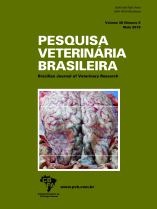 |
|
|
|
Year 2018 - Volume 38, Number 5
|

|
Etiological, epidemiological, clinical and pathological characterization of meningoencephalitis in cattle by bovine herpesvirus in the State of Goiás, Brazil, 38(5):902-912
|
ABSTRACT.- Blume G.R., Silva L.F., Borges J.R.J., Nakazato L., Terra J.P., Rabelo R.E., Vulcani V.A.S. & Sant’Ana F.J.F. 2018. [Etiological, epidemiological, clinical and pathological characterization of meningoencephalitis in cattle by bovine herpesvirus in the State of Goiás, Brazil.] Caracterização etiológica, epidemiológica e clínico-patológica da meningoencefalite por herpesvírus bovino em bovinos no Estado de Goiás. Pesquisa Veterinária Brasileira 38(5):902-912. Laboratório de Diagnóstico Patológico Veterinário, Universidade de Brasília, Brasília, DF 70636-020, Brazil. E-mail: santanafjf@yahoo.com
Twenty six cases of bovine herpetic meningoencephalitis diagnosed from 2010-2016 in Goiás state, Brazil, were studied. Affected cattle were mainly 60-day to 18-month-old. There was no association of the disease with sex and seasonality. The disease was found in all five mesoregions with a higher prevalence in southern and central state of Goiás. Clinical signs more frequently observed included blindness, incoordination, circling, excessive salivation, and ataxia. Main gross findings in the brain were congestion with swelling and flattening of gyri, softening and yellow discoloration of cerebral cortex and hemorrhagic foci. In five cases no gross changes were observed in the brain and in four cases there is no information. The main histopathological changes were in the cortex of telencephalic lobes, especially the frontal and parietal; however less prominent and less frequently found lesions occurred in the thalamus, basal nuclei, midbrain, pons, medulla oblongata, cerebellum, and hippocampus. All cases presented lymphoplasmocytic meningoencephalitis and intranuclear basophilic inclusion bodies in astrocytes, less commonly in neurons. Other frequent lesions included segmental laminar neuronal necrosis (red neurons), spongiosis, swollen vascular endothelial nuclei, gliosis (focal and diffuse), hypertrophy of astrocytes, infiltration of gitter cells, congestion, and hemorrhage. Lesions less frequently observed were Alzheimer type II astrocytes, residual lesion and neuronophagia. The most frequently affected cortical layers by neuronal necrosis and edema were external and internal granular, molecular, and pyramidal cell layers. Gyri and sulci were equally affected. Of the 26 cases, in 2 (7.69%) the DNA of BoHV-5 was amplified with samples fixed in 10% formalin and paraffin-embedded. DNA of BoHV-1 was identified in another case (3.84%) where, positive to BoHV-1, fresh samples were used. |
| |
|
|
| |
|
 |